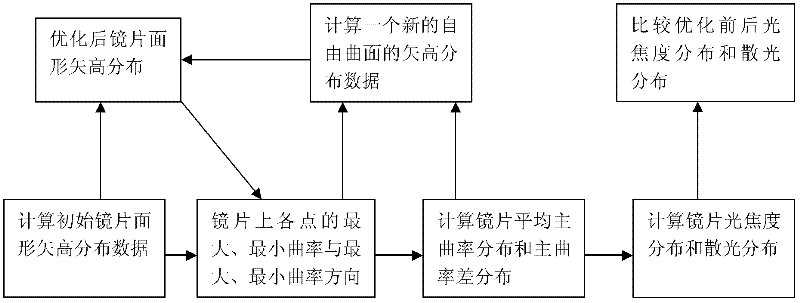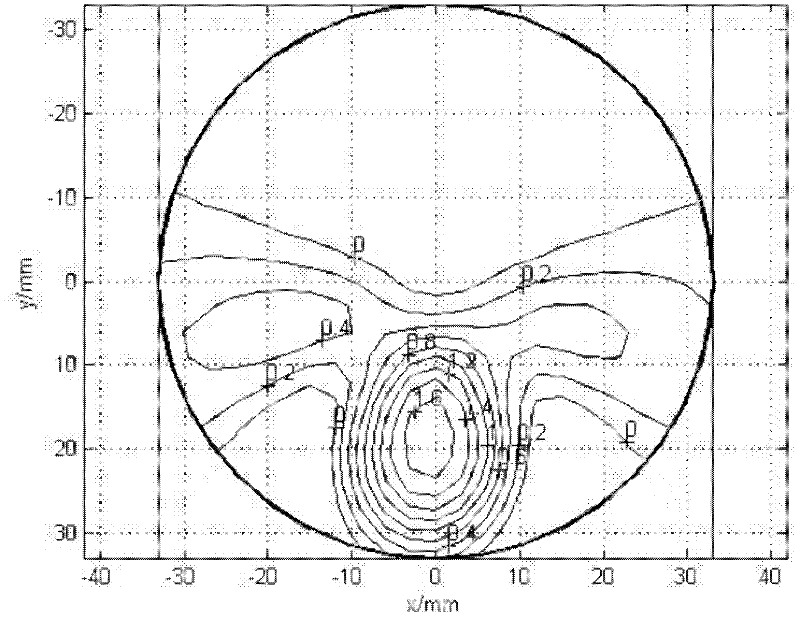Optimization method for reducing astigmatism of progressive additional lens
A progressive multi-focus, optimization method technology, applied in the direction of installation, optics, instruments, etc., can solve the problems that the distribution of astigmatism cannot be very ideal, there is no lens optimization, and the effective viewing area is not improved well, so as to achieve effective and reliable The viewing area is enlarged, the astigmatism is reduced, and the optimization effect is uniform.
- Summary
- Abstract
- Description
- Claims
- Application Information
AI Technical Summary
Problems solved by technology
Method used
Image
Examples
Embodiment 1
[0037] In this embodiment, the design requirements parameters of the lens to be processed are: the power of the far point lens is 0 diopter, the amount of light added between the far point and the near point is 1.8 diopter, and the lens channel length h=14 mm.
[0038] The lens parameters of the lens to be processed are: diameter 66mm, refractive index 1.523.
[0039] See attached figure 1 , which is a schematic diagram of the partitions of the progressive multifocal lens. The surface of the lens is divided into a distance vision zone 1, an intermediate transition zone 2, a near vision zone 3 and an astigmatism zone 4.
[0040] See attached figure 2 , which is a flow chart of steps for optimizing the astigmatism of the progressive multifocal lens provided in this embodiment, and the specific steps are:
[0041] 1. Sag height distribution of initial lens surface shape
[0042] In this embodiment, the initial sagittal height distribution data z of the progressive multifocal ...
Embodiment 2
[0067] The implementation steps are as in Example 1, wherein θ is 3°, and M is 35.
[0068] See attached Figure 8 , which is the contour line diagram of the equal power of the progressive multifocal lens processed by the astigmatism optimization method provided in Embodiment 2 of the present invention. Compared image 3 with Figure 8 It can be seen that after adopting the technical solution provided by Embodiment 2 of the present invention, the isocontour line with a focal power of 0 diopter becomes flatter, indicating that the clear range of the far vision zone is obviously expanded, and the wearer's effective viewing zone is improved.
[0069] See attached Figure 9 , which is the contour line map of the astigmatism of the progressive multifocal lens processed by the astigmatism optimization method provided in Embodiment 2 of the present invention. Compared Figure 5 with Figure 9 It can be seen that after adopting the technical solution provided by Embodiment 2, th...
Embodiment 3
[0071] The implementation steps are as in Example 1, wherein θ is 18°, and M is 20.
[0072] See attached Figure 10 , which is the contour map of the equal power of the progressive multifocal lens processed by the astigmatism optimization method provided in Embodiment 3 of the present invention. Compared image 3 with Figure 10 It can be seen that after adopting the technical solution provided by Embodiment 3 of the present invention, the isocontour line with a focal power of 0 diopter becomes flatter, indicating that the clear range of the far vision zone is significantly expanded, and the wearer's effective viewing zone is improved.
[0073] See attached Figure 11 , which is the contour line map of the astigmatism of the progressive multifocal lens processed by the astigmatism optimization method provided in the third embodiment of the present invention. Compared Figure 5 with Figure 11 It can be seen that after adopting the technical solution provided by Embodime...
PUM
 Login to View More
Login to View More Abstract
Description
Claims
Application Information
 Login to View More
Login to View More - R&D
- Intellectual Property
- Life Sciences
- Materials
- Tech Scout
- Unparalleled Data Quality
- Higher Quality Content
- 60% Fewer Hallucinations
Browse by: Latest US Patents, China's latest patents, Technical Efficacy Thesaurus, Application Domain, Technology Topic, Popular Technical Reports.
© 2025 PatSnap. All rights reserved.Legal|Privacy policy|Modern Slavery Act Transparency Statement|Sitemap|About US| Contact US: help@patsnap.com



